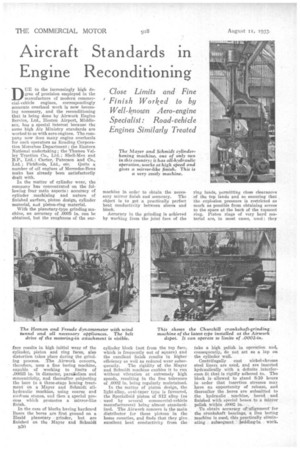Aircraft Standards in Engine Reconditioning
Page 40

Page 41

If you've noticed an error in this article please click here to report it so we can fix it.
DtiE to the increasingly high degree of precision employed in the manufacture of modern commercial-vehicle engines, correspondingly accurate overhaul work is now becoming necessary, and the reconditioning that is being done by Airwork Engine Service, Ltd., Heston Airport, Middlesex, has a special interest because the same high Air Ministry standards are worked to as with aero engines. The company now does many engine overhauls for such operators as Reading Corporation Motorbus Department ; the Eastern National undertaking; the Thames Valley Traction Co., Ltd. ; Shell-httex and 33.P., Ltd.; Carter, Paterson and Co.,
Ltd.; Pickfords, Ltd., etc. Quite a number of oil engines of Mercedes-Benz make has already been satisfactorily dealt with.
In the matter of cylinder wear, the company has concentrated on the following four main aspects: accuracy of cylinder machining and nature of finished surface, piston design, cylinder material, and piston-ring material.
With the planetary-type grinding machine, an accuracy of .0005 in. can be obtained, but the roughness of the sur face results in high initial wear of the cylinder, piston and ring faces, also distortion takes place during the grinding process. The Airwork concern, therefore, uses a fine boring machine, capable of working to limits of .00025 in. in diameter, parallelism and concentricity, and thereafter_ subjecting the bore to a three-stage honing treatment on a Mayer and Schmidt allhydraulic machine, using coarse and medium stones, and then a special process which promotes a mirror-like finish.
• In the caae of blocks having hardened liners the bores are first ground on a Heald planetary grinder, but are finished on the Mayer and Schmidt p30 machine in order to obtain the necessary mirror finish and accuracy. The object is to get a practically perfect heat conductivity between sleeve and block.
Accuracy in the grinding is achieved by working from the joint face of the cylinder block (not from the top face, which is frequently out of square l and the excellent finish results in higher efficiency as well as reduced wear subae quently. The rigidity of the Mayer and Schmidt machine enables it to run without vibration at• extremely high speeds, resulting in the fine tolerance of .0002 in. being regularly maintained.
In the matter of piston design, the light-alloy, oval-taper type is favoured, the Specialloid piston of 512 alloy (as used by several commercial-vehicle manufacturers) being almost standardized. The Airwork concern is the main distributor for these pistons in the home counties, and finds that they give excellent heat conductivity from the ring lands, permitting close clearances of the top lands and so ensuring that the explosion pressure is restricted as much as possible from obtaining access to the space at the back of the topmost ring. Piston rings of very hard material are, in most cases, used; they
take a high .polish in operation and, consequently, do not act as a lap on the cylinder wall.
Centrifugally cast nickel-chrome steel liners are used, and are inserted hydraulically with " a definite interference fit that is rigidly adhered to. The block fa • allowed to stand 840 hours in order that insertion stresses may have an opportunity of release, and thereafter the bores are submitted to the hydraulic machine, bored and finished with special hones to a Mirror polish within 00.002 in.
To obtain accuracy orldignmentfor the crankshaftbeatings, a line boring machine is used, this practically eliminating sobseciuent . bedding-in. work.
Crankshafts are reconditioned on Churchill grinding machine of the latest type, which works to limits of .0011P in. Valve-seat reconditioning and inserts are another phase of the work, the inserts usually employed being the Hagen type, made by the Harold Andrews Grinding Co., Ltd., of Birmingham, which is an associated concern.
Separate workshops are devoted to engine eve rhaul, one being set aside for aero engines and under the supervision of a 1)-licence man, who organizes it on strictly A.I.D. lines, and a second for car, commercial-motor, marine and oilengine overhauls.
One Of the most up-to-date enginetesting houses in the country is available, having a Heenan and Froude dynamometer suitable for units of up to 450 b.h.p. There is a wind tunnel to give air-cooling conditions similar to those of an aeroplane in normal flight, affording wind speeds up to 150 m.p.h. Water temperature and oil' tempera ture also can be controlled. Either direction of rotation is provided for, and there is an electric attachment for motoring-in stiff engines. This plant is available also for testing new types of engine and Air Ministry type-test requirements are complied with. Having test facilities on the spot increases the value of the whole workshop, and oilengine users are appreciating the fact.




















































































